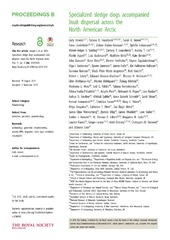Specialized sledge dogs accompanied Inuit dispersal across the North American Arctic
Ameen, Carly; Feuerborn, Tatiana R.; Brown, Sarah K.; Linderholm, Anna; Hulme-Beaman, Ardern; Lebrasseur, Ophelie; Sinding, Mikkel Holger Strander; Lounsberry, Zachary T.; Lin, Audrey T.; Appelt, Martin; Bachmann, Lutz; Betts, Matthew; Britton, Kate; Darwent, John; Dietz, Rune; Fredholm, Merethe; Gopalakrishnan, Shyam; Goruinova, Olga I.; Grønnow, Bjarne; Haile, James; Hallsson, Jón Hallsteinn; Harrison, Ramona; Heide-Jørgensen, Mads-Peter; Knecht, Rick; Losey, Robert J.; Masson-MacLean, Edouard; McGovern, Thomas H.; McMagnus-Fry, Ellen; Meldgaard, Morten; Midtdal, Åslaug; Moss, Madonna L.; Nikitin, Iurii G.; Nomokonova, Tatiana; Palsdottir, Albina Hulda; Perri, Angela; Popov, Aleksandr N.; Rankin, Lisa; Reuther, Joshua D.; Sablin, Mikhail V.; Schmidt, Anne Lisbeth; Shirar, Scott; Smiarowski, Konrad; Sonne, Christian; Stiner, Mary C.; Vasyukov, Mitya; West, Catherine F.; Ween, Gro Birgit; Wennerberg, Sanne Eline; Wiig, Øystein; Woollett, James; Dalén, Love; Hansen, Anders J.; Gilbert, Marcus Thomas Pius; Sacks, Benjamin N; Frantz, Laurent A.F.; Larson, Greger; Dobney, Keith; Darwent, Christyann M.; Evin, Allowen
Peer reviewed, Journal article
Published version

Åpne
Permanent lenke
https://hdl.handle.net/1956/22115Utgivelsesdato
2019-11-27Metadata
Vis full innførselOriginalversjon
https://doi.org/10.1098/rspb.2019.1929Sammendrag
Domestic dogs have been central to life in the North American Arctic for millennia. The ancestors of the Inuit were the first to introduce the widespread usage of dog sledge transportation technology to the Americas, but whether the Inuit adopted local Palaeo-Inuit dogs or introduced a new dog population to the region remains unknown. To test these hypotheses, we generated mitochondrial DNA and geometric morphometric data of skull and dental elements from a total of 922 North American Arctic dogs and wolves spanning over 4500 years. Our analyses revealed that dogs from Inuit sites dating from 2000 BP possess morphological and genetic signatures that distinguish them from earlier Palaeo-Inuit dogs, and identified a novel mitochondrial clade in eastern Siberia and Alaska. The genetic legacy of these Inuit dogs survives today in modern Arctic sledge dogs despite phenotypic differences between archaeological and modern Arctic dogs. Together, our data reveal that Inuit dogs derive from a secondary pre-contact migration of dogs distinct from Palaeo-Inuit dogs, and probably aided the Inuit expansion across the North American Arctic beginning around 1000 BP.
